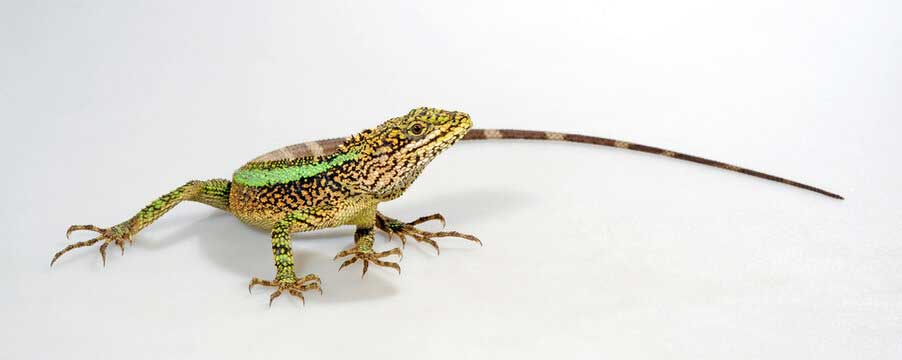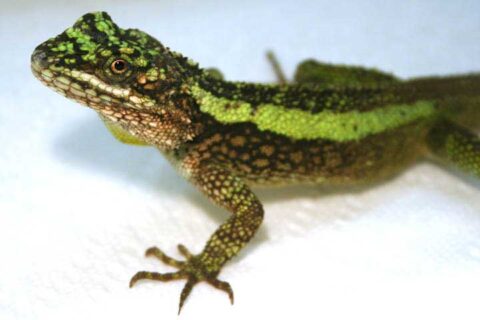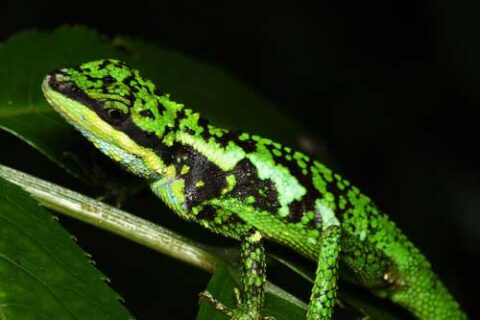
Content |
|---|
Distribution and habitat
Of all species of Japalura, this is the one with the largest distribution area in southwest China.
It extends north from Henan province, passing through gansu, Sichuan, Yunnan, Goizhou and Hubei, to the east of Hunan province.
The Green striped tree dragon lives up to an altitude of 3000 m. They are called creek buddies because they are constantly near small mountain streams or waterfalls.
The Green striped tree dragon it is a diurnal species, predominantly arboreal, herbaceous cover. The habitat can be classified as subtropical mountain forests.
Description
The basic color of the body is brown, on the head and legs shows a yellow and green coloration. Depending on how they feel, of the course of the day, stress and courtship behavior, color range varies from bright greens to browns, going through muted dark browns to an almost black coloration.
The most striking feature of Green striped tree dragon are the dorsolateral green stripes.
In the male, stripes look straight with sharp edges and marginal lines. Dorsally (between the stripes) appears dark brown with few colored spots, respectively fine. Lines.
Female has irregularly shaped dorsolateral stripes, notched or jagged. Seen from above, there are dorsal connections at regular intervals across the back. In the resulting interspaces, darker, highlights a chain of rhombuses, which remains visible up to the base of the tail.
The toes are delicate and have claws. This makes them perfectly adapted to rocky terrain and trees..
Measurements
Males reach a total length of 35 cm., the females 30 cm..
Sex determination
The species has a sexual dichromatism with the respective dorsolateral stripe.
The body of the male appears long and thin. The legs are clearly stronger.
Females have a round body due to egg laying. For this reason, the legs don't seem that strong.
Behavior
The species is shy in nature and tends to panic. This can be counteracted with a good structure in the terrarium..
With their own offspring this tendency to panic jumps improves, but there is no guarantee.
The terrarium must be densely planted with vegetation and have sufficient depth, this gives to Green striped tree dragon a sense of security. No effort to feed these animals, rather you have to be content with watching them hunt.

It is evident that the Green striped tree dragon depends on wet leaves and running water. If you offer this, they will show a lot of activity.
At night, animals are not completely inactive, but they are alert to capture some flying insect.
It is very important that the species splendid japalure I can only stay as a couple. Females are territorial, so you can only have a female with a male.
Hibernation
The species is native to the high mountains of the Himalayas, where there is a climatic winter. In the terrarium you also have to make an effort to achieve it. If he terrarium placed in a cold room from the start, hibernation in the terrarium is also possible. To preserve plants, today LED lighting is available in the daylight spectrum.
Hibernation should last 4 weeks.
Courtship, mating and breeding
The species displays a rich spectrum of behavior.
Males turn completely black for courtship, only the green dosolateral stripes are visible and white patches appear on the throat. The male nods constantly, signaling their willingness to mate.
Willingness to mate.
The female can also change a little color, but this is rather behavioral, until you show your anger. But, Mating only occurs when the female corresponds to the courtship of the male by briefly opening her throat. The male would never approach the female beforehand.
Mating is brief and is terminated by the female. She holds the male against the back wall during this time and then leaves the secure grip.
The female can bury exactly 4 nides at intervals of 4 weeks per season – from winter slumber to monsoon rainy season. Then it takes a break of a few weeks to return to producing 4 nides at intervals of 4 weeks in fall to hibernation. After about 90 days, the young hatch.
Diet and supplements
The Green striped tree dragon it is insectivorous, which means that these lizards feed exclusively on insects.
These lizards will be offered everything they can bear in terms of insects. They prefer flying insects like moths, flies and wasps. It should be offered as often as possible, since it is an excellent occupation. Meadowsweet plankton should be preferred, as well as various species of crickets, grasshoppers and cockroaches, even waxworms and black beetle larvae.
Supplementation
Insects must be well fed and, of course, still pollinated with a multivitamin and mineral preparation. Herpetal or Korvimin ZVT range with a calcium blend is recommended.
Terrarium

For a pair of this species a terrarium with the dimensions 100 x 60 x 100 (length x widht x hight).
Equipment
The habitat is subtropical mountain forests with a flowing mountain stream and this should be recreated in a terrarium. One focuses on the essential, what are plants, soil and water.
The back walls are designed so that many plants can thrive there.
The substrate is filled high enough and moist. Plants and many branches offer the freedom of movement of a tree. A stream of water simulates the trickle of streams from a slope, which already suggests that no water is offered at the bottom of the substrate. The substrate is only visited by females to lay eggs or by insects that have strayed into it..
Sunbathing areas are subordinate, since the Green striped tree dragon prefers cooler and shady places. Lighting is mainly for plants.
Plants
Plants not only regulate the climate in the terrarium, they also serve as protection, residence and welfare for animals.
Planting with ficus species, as the “oak leaf ficus” Ficus quericifolia y Ficus scandens, is the most sensible option. It also, a variety of other plants can be chosen, all of which must tolerate high humidity and be small-leaved. These may include, the Chirita Tamiana, the Pellionia deveauna, the Hemigraphis repanda , and Parthenocissus inserta they are suitable, but it is also enough to choose the ivy Epipremnum pinnatum.
Substrate
The choice of substrate is important because it must retain a lot of moisture, must not become moldy and must have good egg-laying properties. An unfertilized soil is recommended, preferably from deciduous forests.
The substrate must have 15 cm in height so that the female has optimal conditions for laying eggs. If the female feels insecure, if the substrate is too poor or not moist enough, this can lead to an egg-laying drought.
Illumination
Lighting in a forest terrarium plays a subordinate role for animals, not for plants. The Japalura splendida they are not usually sun worshipers, rather they avoid a light level. It is important to avoid excessive heat by using good lighting.
Fluorescent tubes and, in the news, LEDs have proven themselves.
Example:
For a terrarium of 100 x 60 x 100 cm., 6 tubos BioVital -full spectrum, T5, with 39 High output watts have proven themselves. More and more I'm leaning towards LED lighting plus a Solar Raptor from 35 watts.
Temperatures
The basic temperature in the terrarium should be 27°C, but it is also necessary to foresee cooler areas. It can also be 35°C at certain points by means of a focus, but this should not raise the base values.
For the Green striped tree dragon it is much more important to achieve a night coolness of up to 12°C.
Humidity
Relative humidity should be 50-60% during the day and increase to about 90% At night.
the cold night, the plants, the moist substrate and the walls, plus a waterfall, will inevitably increase humidity at night.
For sale "Green striped tree dragon"
The price of a Green striped tree dragon ranges between 35 – 45 EUR.
Sources
HALLERMANN, Jakob (2005): Mit Hörnern, Kämmen und Gleithäuten – die bizarren Baumagamen. Reptilia 10 (1), NTV Verlag, Münster; 18-25 S.
KÄSTLE, Werner & H. Hermann SCHLEICH (2000): Zitat in: JACOB HALLERMANN (2005) Mit Hörnern, Kämmen und Gleithäuten – die bizarren Baumagamen. Reptilia10(1) NTV Verlag, Münster, 18-25 S.
Laue, E. 2009. Erfahrungen mit Krankheiten und Verlusten bei der langjährigen Pflege und Nachzucht cer Chinesischen Bergagame Japalura splendida, veranschaulicht durch drei Fallbeispiele. Iguana-Rundschreiben 22 (1): 21-30
LAUE, Esther (2005): Zur Haltung und Vermehrung der Chinesischen Bergagame Japalura splendida BARBOUR & DUNN 1919. Elaphe 13 (1): 20-30
LAUE, Esther (2007): Die Chinesische Bergagame Japalura splendida Vivaria-Verlag 95 pp.
MANTHEY, Ulrich & Norbert SCHUSTER (1999): Agamen. NTV Verlag, Münster
SCHRADIN, Heiko (2004): Haltung und Nachzucht der Chinesischen Bergagame (Japalura splendida) –Reptilia 9(5), NTV Verlag, Münster, 56-66 S.
